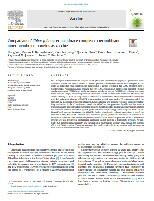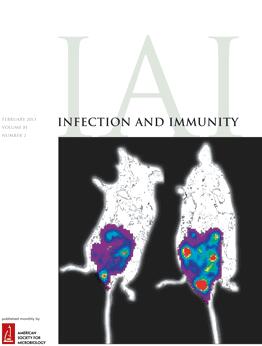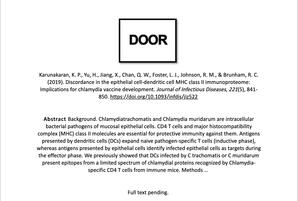Brunham, Robert C.
Person Preferred Name
Robert C. Brunham
Related Works
Content type
Digital Document
Abstract
Tuberculosis (TB) is one of the leading causes of death from infectious diseases, killing approximately 1.3 million people worldwide in 2022 alone. The current vaccine for TB contains a live attenuated bacterium, Mycobacterium bovis BCG (Bacille Calmette-Guérin). The BCG vaccine is highly effective in preventing severe forms of childhood TB but does not protect against latent infection or disease in older age groups. A new or improved BCG vaccine for prevention of pulmonary TB is urgently needed.
In this study, we infected murine bone marrow derived dendritic cells from C57BL/6 mice with M. bovis BCG followed by elution and identification of BCG-derived MHC class I and class II-bound peptides using tandem mass spectrometry. We identified 1436 MHC-bound peptides of which 94 were derived from BCG. Fifty-five peptides were derived from MHC class I molecules and 39 from class II molecules. We tested the 94 peptides for their immunogenicity using IFN- γ ELISPOT assay with splenocytes purified from BCG immunized mice and 10 showed positive responses. Seven peptides were derived from MHC II and three from MHC class I. In particular, MHC class II binding peptides derived from the mycobacterial surface lipoprotein Mpt83 were highly antigenic. Further evaluations of these immunogenic BCG peptides may identify proteins useful as new TB vaccine candidates.
Origin Information
Content type
Digital Document
Abstract
Chlamydia trachomatis is the most important infectious cause of infertility in women with important implications in public health and for which a vaccine is urgently needed. Recent immunoproteomic vaccine studies found that four polymorphic membrane proteins (PmpE, PmpF, PmpG and PmpH) are immunodominant, recognized by various MHC class II haplotypes and protective in mouse models. In the present study, we aimed to evaluate genetic and protein features of Pmps (focusing on the N-terminal 600 amino acids where MHC class II epitopes were mapped) in order to understand antigen variation that may emerge following vaccine induced immune selection. We used several bioinformatics platforms to study: i) Pmps’ phylogeny and genetic polymorphism; ii) the location and distribution of protein features (GGA(I, L)/FxxN motifs and cysteine residues) that may impact pathogen-host interactions and protein conformation; and iii) the existence of phase variation mechanisms that may impact Pmps’ expression. We used a well-characterized collection of 53 fully-sequenced strains that represent the C. trachomatis serovars associated with the three disease groups: ocular (N=8), epithelial-genital (N=25) and lymphogranuloma venereum (LGV) (N=20). We observed that PmpF and PmpE are highly polymorphic between LGV and epithelial-genital strains, and also within populations of the latter. We also found heterogeneous representation among strains for GGA(I, L)/FxxN motifs and cysteine residues, suggesting possible alterations in adhesion properties, tissue specificity and immunogenicity. PmpG and, to a lesser extent, PmpH revealed low polymorphism and high conservation of protein features among the genital strains (including the LGV group). Uniquely among the four Pmps, pmpG has regulatory sequences suggestive of phase variation. In aggregate, the results suggest that PmpG may be the lead vaccine candidate because of sequence conservation but may need to be paired with another protective antigen (like PmpH) in order to prevent immune selection of phase variants.
Origin Information
Content type
Digital Document
Abstract
The Chlamydial outer membrane complex (COMC) from the elementary body (EB) is a protein rich insoluble outer membrane shell from which cytosolic proteins have been extracted with detergent. In this study we conducted mass spectrometry experiments to detect proteins in the COMC prepared from C. muridarum EB. Proteomic analysis showed that the COMC contained 75 proteins that included 10 outer membrane proteins (OMPs) such as the major outer membrane protein (MOMP) and polymorphic membrane proteins (Pmps) that were previously identified as CD4 T cell vaccine candidates. We tested the vaccine efficacy of COMC in comparison to individual or combination of recombinant OMPs formulated with Th1 polarizing adjuvant DDA/MPL in two murine genital tract models (C. muridarum and C. trachomatis) by measuring organismal shedding, tubal pathology and immune responses including neutralizing antibodies. In the C. muridarum model, the COMC vaccine generated broadly reactive immune responses against multiple outer membrane proteins, high levels of EB binding and neutralizing antibody and exhibited superior protection against genital infection and pathology when compared to the recombinant PmpG vaccine. Denaturing the COMC by boiling significantly reduced protection. In the C. trachomatis model, the COMC vaccine also conferred greater protection compared to individual or multiple recombinant outer membrane proteins. Immunization with multiple COMCs from C. trachomatis serovars D, F and J generated neutralizing antibodies against multiple C. trachomatis serovars. We conclude that broader immunogenicity and generation of neutralizing antibody may explain the superior efficacy of COMC vaccine. The study suggests that conformationally intact proteins will be necessary for a successful recombinant OMP vaccine.
Origin Information
Content type
Digital Document
Abstract
Surveillance and defense of the enormous mucosal interface with the nonsterile world are critical to protecting the host from a wide range of pathogens. Chlamydia trachomatis is an intracellular bacterial pathogen that replicates almost exclusively in the epithelium of the reproductive tract. The fallopian tubes and vagina are poorly suited to surveillance and defense, with limited immune infrastructure positioned near the epithelium. However, a dynamic process during clearing primary infections leaves behind new lymphoid clusters immediately beneath the epithelium. These memory lymphocyte clusters (MLCs) harboring tissue-resident memory (Trm) T cells are presumed to play an important role in protection from subsequent infections. Histologically, human Chlamydia MLCs have prominent B cell populations. We investigated the status of genital tract B cells during C. muridarum infections and the nature of T cells recovered from immune mice using immune B cells as antigen-presenting cells (APCs). These studies revealed a genital tract plasma B cell population and a novel genital tract CD4 T cell subset producing both gamma interferon (IFN-γ) and interleukin-13 (IL-13). A panel of CD4 T cell clones and microarray analysis showed that the molecular fingerprint of CD4γ13 T cells includes a Trm-like transcriptome. Adoptive transfer of a Chlamydia-specific CD4γ13 T cell clone completely prevented oviduct immunopathology without accelerating bacterial clearance. Existence of a CD4γ13 T cell subset provides a plausible explanation for the observation that human peripheral blood mononuclear cell (PBMC) Chlamydia-specific IFN-γ and IL-13 responses predict resistance to reinfection.
Origin Information
Content type
Digital Document
Abstract
Abstract
Background
Chlamydiatrachomatis and Chlamydia muridarum are intracellular bacterial pathogens of mucosal epithelial cells. CD4 T cells and major histocompatibility complex (MHC) class II molecules are essential for protective immunity against them. Antigens presented by dendritic cells (DCs) expand naive pathogen-specific T cells (inductive phase), whereas antigens presented by epithelial cells identify infected epithelial cells as targets during the effector phase. We previously showed that DCs infected by C trachomatis or C muridarum present epitopes from a limited spectrum of chlamydial proteins recognized by Chlamydia-specific CD4 T cells from immune mice.
Methods
We hypothesized that Chlamydia-infected DCs and epithelial cells present overlapping sets of Chlamydia-MHC class II epitopes to link inductive and effector phases to generate protective immunity. We tested that hypothesis by infecting an oviductal epithelial cell line with C muridarum, followed by immunoaffinity isolation and sequencing of MHC class I- and II-bound peptides.
Results
We identified 26 class I-bound and 4 class II-bound Chlamydia-derived peptides from infected epithelial cells. We were surprised to find that none of the epithelial cell class I- and class II-bound chlamydial peptides overlapped with peptides presented by DCs.
Conclusions
We suggest the discordance between the DC and epithelial cell immunoproteomes has implications for delayed clearance of Chlamydia and design of a Chlamydia vaccine.
Origin Information





